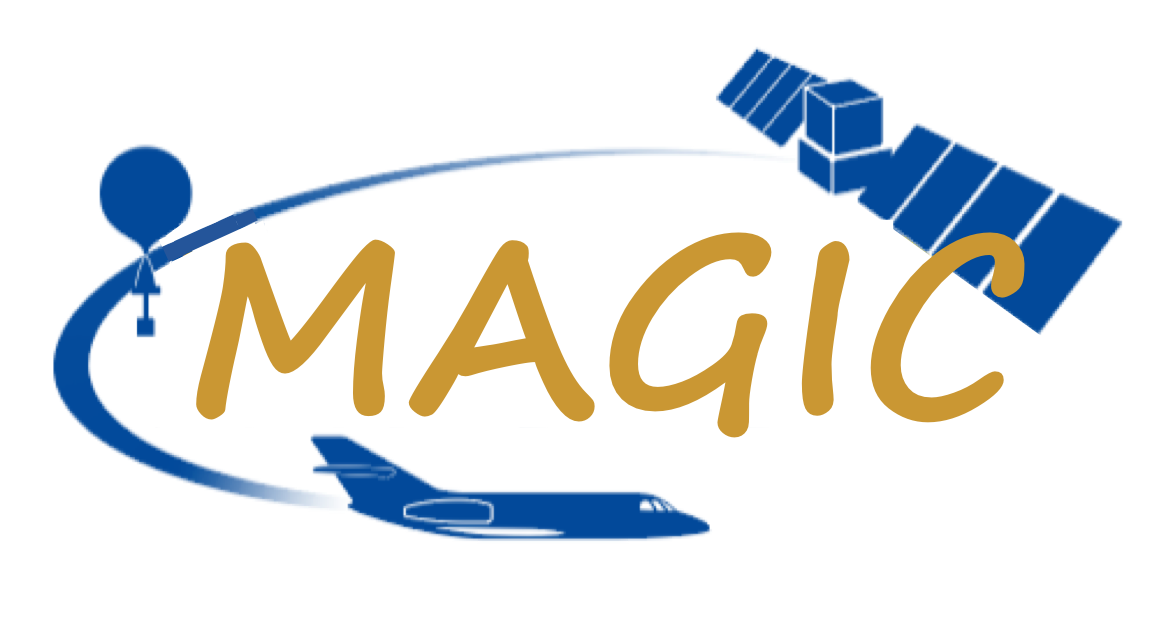The MAGIC2023 campaign
The MAGIC2023 campaign takes place in France, in the vicinity of Reims (Grand Est region), from 11th to 21st September 2023. It is the second phase of MAGIC2022, that took place in Octbober 2023 in the same region.
The main objective of the campaign is to study anthropogenic emissions of CO2 and CH4 from this mid-sized European city as well as from nearby methanizers and industrial sites. A second objective is to validate weighted columns of greenhouse gases retrieved from spaceborne observations (OCO-2, Sentinel-5P, IASI) in this particular environment. A new third objective concerns the validation of the Short Comb Atmospheric Lidar Experiment (SCALE) project led by CNES.
An international consortium of about 50 scientists will operate a battery of instruments deployed on the ground and aboard dozens of balloons, as well as onboard three research aircrafts.
This campaign is funded by CNES and CNRS and hosted by GSMA. Team supports also include University of Reims-Champagne Ardennes, as well as Ecole polytechnique, Sorbonne Université, CEA, Universities of Lille and Orléans, and NASA/JPL.
Lead scientist is Dr. Cyril Crevoisier (CNRS/LMD). Local host is Dr. Lilian Joly (CNRS/GSMA).
Scientific objectives
Cities cover a very small part (<1%) of the world’s surface area, but account for 67-76% of global energy-related CO2 emissions. Moreover, half of the world’s population lives in cities, a share that will probably reach 70% by 2050. Understanding emissions from cities is therefore a priority objective to improve our knowledge of global anthropogenic emissions and to implement local actions to fight against climate change.
The ability to conduct accurate inventories of city emissions at multiple geographic levels is essential for local actors to understand the magnitude of urban emissions and to assess the relative contribution of different factors to overall emissions in order to identify opportunities for mitigation, develop a comprehensive “climate” action plan, and implement long-term measurement programs.
One of the objectives of space missions dedicated to greenhouse gases is precisely to participate in the global observation network of greenhouse gases and in particular of anthropogenic emissions. It is thus of the upmost importance to evaluate the capacity of these space missions to observe signatures of anthropogenic, and in particular urban, emissions by measuring weighted columns over the entire atmospheric column.
The main objective of the MAGIC2023 campaign will be to explore more the possibility of determining the anthropogenic emissions of a representative medium-sized European city, Reims, and nearby methane digesters and industrial sites, from column-weighted measurements of CO2 and CH4, by deploying a wide range of instruments covering various space and time scales, combining ground, airborne and space-based observations.
The campaign will shed light on the capabilities of current (OCO-2, Sentinel-5P) and future (CO2M, MicroCarb, Sentinel-5) space missions to capture these emissions. The measurements will also provide information on the spatio-temporal variability of gases at the scale of a city and thus on the expected heterogeneity within the measurement pixels of these missions.
Finally, the SCALE insrument will be deployed for the first time, flying onboard SAFIRE ATR42 research aircraft. Coordinated measurement between ground-based and airbone instruments will be made to evaluate SCALE performances in measuring column weighted CO2 from this active technique.
The location
The medium-sized city chosen for the MAGIC2023 campaign is the city of Reims. Indeed, this city of the Grand-Est region offers several advantages:
- By its surface area (47.02 km2), its population (182,211 inhabitants for the city, 211,812 for the agglomeration) and its industry, Reims is representative of European medium-sized cities.
- The region is sufficiently large and with little hilly terrain to be well represented in the dispersion models.
- Reims offers a sufficient number of suitable locations to set up the numerous instruments planned, including various sites of the University of Reims-Champagne-Ardennes.
- The Grand-Est region hosts a large number of methane digesters.
- Finally, the research infrastructure developed in the framework of the AEROLAB project (AtmosphEric Research and Observations LABoratory) led by Lilian Joly (GSMA) will allow us to benefit from many ground-based and airborne facilities.
The instruments
About 40 instruments are deployed during MAGIC2023 two week-campaign:
- 45 light balloons (BLD type) should be launched from the MDH site of URCA, carrying a diversity of sensors measuring 0-30 km profiles of gas concentrations, temperature and wind, as well as aerosol counters.
- Three research aircrafts are joining the campaign for more than 40 hours of scientific flight: SAFIRE Piper, SAFIRE ATR52 and Gerfaut ULM-type aircraft. Coordinated flights are organized to take advantage of the full suite of instruments onboard the planes.
- Ground-based measurements will include: mobile Fourrier Transform Spectrometers operating in the infrared, a 50m tower located at URCA, aerosol lidar and photometer, and a mobile station.
Measurement strategy include raster patterns above the cities of Reims, Epernay and Châlon-en-Champagne, circles around the cities, up-wind and down-wind measurements, as well as long range flights to nearby methane digesters and industrial sites.
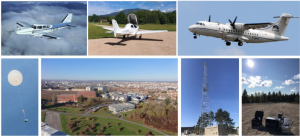
The team
All together, the campaign involves 10 teams from 3 countries:
- LMD (CNRS, Ecole polytechnique, Sorbonne Université, ENS)
- GSMA (CNRS, Université de Reims-Champagne Ardennes)
- LSCE (CNRS, CEA)
- LERMA (CNRS, Sorbonne Université)
- LOA (CNRS, Université de Lille)
- LPC2E (CNRS, Université d’Orléans)
- SAFIRE (CNRS, Météo-France, CNES)
- CNES
- KIT (Germany)
- NASA (USA)
Campaign logbook
Campaign summary
The MAGIC2023 campaign is now over. It is time to make a summary.
19 meteorological balloons have been launched from MDH site in Reims: 16 carrying AirCore for CO2/CH4/CO profiling, 3 carrying O3 sondes and 3 carrying aerosols counters. There has been 6 nighttime launches (including recovery and analysis well beyond midnight) and several co-locations with satellite overpassing (IASI-B, IASI-C and TROPOMI).
5 ground-based spectrometers (5 EM27/SUN, 1 CHIRS) have provided thousands of infrared spectra from which total-column of greenhouse gases are going to be estimated. Their locations, changing almost every day, have been carefully chosen to catch the plumes from Reims and Bazancourt industrial site.
7 flights of 3h30 from SAFIRE Piper-Aztec allowed to scan the plumes of Reims and Bazancourt industrial site at 1300 ft and 1900 ft, while Gerfaut performed seven flights to extend the cartography of methane digesters.
Finally, one day saw the joining of SAFIRE ATR42 carrying CNES SCALE lidar. 2 hours of combined measurements from all the ground-based and airborne instruments provided an extensive dataset that will help in the characterization of this new instrument.
All in all, a very successful campaign that builds on the firendly and dedicated spirit of the whole MAGIC team!
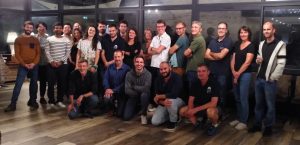
Thursday 21 September
As forecasted for some days now, storm and rain have finally arrived over Reims, declaring the end of MAGIC2023 measurements. It is time for a final visit to the aircraft by several members of the team, while the packing of instruments and field equipment is finalized.

Wednesday 20 September
Winds are blowing strongly today, potentially bringing balloons from Reims up to Belgium. It is thus a nogo situation for them. Fortunately, weather has greatly improved compared to the previous day, making today a great day to deploy our 4 EM27/SUN as well as CHRIS.
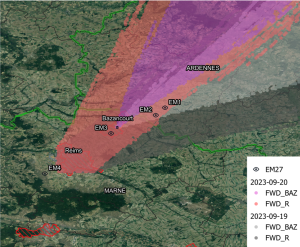
Today objective: catching the plume from the industrual site of Bazancourt. With a South-West wind, the plumes from Reims and Bazancourt are expected to be in the same direction as the previous day. The ground-based spectrometers are thus deployed closer to Bazancourt to maximize the chance to catch the plumes. The EM27/SUN from CNES is placed South of the industrial site, while the ones from GSMA, KIT and LERMA are deployed in a triangle formation. The CHRIS instrument from LOA is placed next to KIT EM27/SUN to combine their measurements near the expected center of the plume.

SAFIRE Piper-Aztec takes-off from Prunay airport at 12:30 LT for its final flight of the campaign. Its flight pattern: a raster over Bazancourt, with legs separated by 2 km.

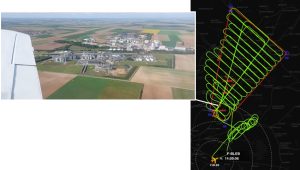
In addition to the groubd-based and airborne measurements, balloon teams took the opportunity of a day off to perform the campaign-end calibration of the Picarro analyzers and to work on data analysis.
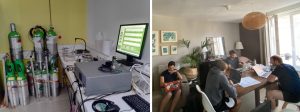
Tuesday 19 September
An early start is planned for the final day of balloon launches with weather forecast showing better measurement conditions in the morning. Rendez-vous is at 7:45 LT for the EM27 teams before the morning briefing at 8:00 LT. Today objective: analyzing the combination of Reims and Bazancourt GHG emissions by deploying all our instruments in the plumes in a South-West/North-East direction.

SAFIRE Piper-Aztec performed a raster pattern with legs perpendicular to the SW wind at 1300ft and 1900ft, as well as a profile between 60m and 3000m in the North-East. A plume of CO2 and CH4 was clearly detected on the legs North of the industrial site.
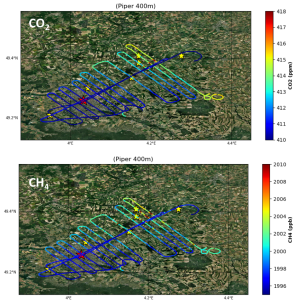
The 4 EM27/SUN were deployed as follow: GSMA EM27 was deployed in the South-West to serve as a reference for the background concentrations; CNES EM27 was deployed between Reims and Bazancourt to catch Reims plume; LERMA EM27 was deployed on the other side of Bazancour; Finally KIT EM27 was deployed in the North-East to catch the end of the plume.

Meanwhile, 4 balloons carrying LMD AirCores were launched by GSMA team from MDH at 10:00, 13:00, 15: 30 and 19:30. Three landed in pasture fields and one in a tree but with an easy reach, making for easy recoveries in beautiful landscales in the Ardennes region.


Monday 18 September
After a full week of measurements, it is time for a day-off the field for the teams. Nonetheless, analysis, instrument checking and campaign planning continue for the remaining days.
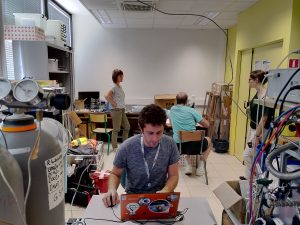

Sunday 17 September
Today, balloon trajectories indicate a landing on Belgium. It is a day-off for the balloon teams.
And the day begins in dense fog, which even obscures the ICOS tower on the MDH site. Fortunately, the weather lifts a little and the EM27s can be deployed. Special safety precautions are taken, however, due to the start of the hunting season.
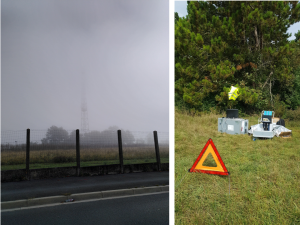
SAFIRE’s piper once again makes a grid of the Reims-Bazancourt area, with the main legacies perpendicular to the south-easterly wind. As for the Gerfaut, it carries out a long transect to the north-west of the area in order to capture the signature of the region’s emission plumes in the background concentrations.

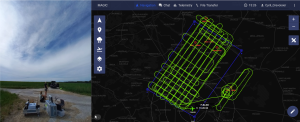

Saturday 16 September
Saturday did not go exactly to plan… due to capricious weather. While a Sentinel-5P pass was scheduled for 12:24 UTC, heavy cloud cover made it impossible to observe from space… and from the ground despite a good start.
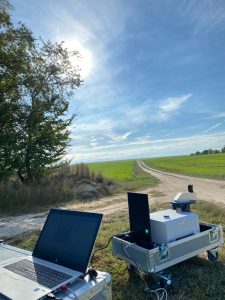
Strong gusts of wind also led to the cancellation of the final balloon release. Two AirCore flights were nevertheless carried out at 10:00 and 12:30 LT, even if the deployment was a bit sporty…
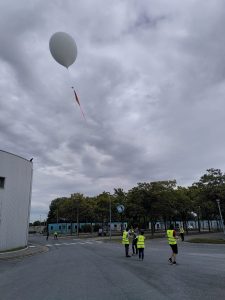
Finally, SAFIRE’s Piper-Aztec was once again able to produce a raster over the city of Reims and the Bazancourt site, even producing a tight grid of the city by regularly passing over the 4 EM27/SUNs deployed on the ground. The 3h20 flight, which started at 13:00 LT, enabled us to acquire precise new data to study GHG emissions in the region.
Meanwhile, the Gerfaut was carrying out GHG concentration measurements over several methaniseurs in the Ardennes.
Finally, sine it is Saturday night, a small gathering at LMD’s accommodation site.

Friday 15 September
Today is devoted to SCALE. And the full suite of instruments is deployed.
Three research aircrafts, making coordinated flights: SAFIRE ATR42 joining on site for 2 hours from Frankazal with SCALE and a Picarro onboard; SAFIRE Piper from Prunay to meaure CO2, CH4, CO, O3 and NOX; Gerfaut Dynamic WT9 from Prunay to measure CO2 and CH4 West of Reims.

Five solar spectrometers and one mobile aerosol stations are deployed along the aircraft tracks. 3 EM27/SUN are West and 1 EM27/SUN East of Bazancourt to study GHG plumes. Over each location, the three planes made some overpasses, covering 4 altitudes, in order to help interpret the gas columns measured by the spectrometers.
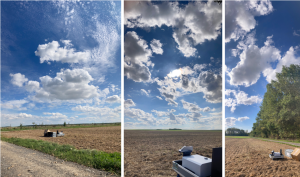
Finally, 5 meteorological ballons were launched. Four of them made 0-30 km profiles of GHG with LMD light AirCores. One, deployed by the joinded NASA-LPC2E team, was dedicated to measuring aerosol characteristics. Except for the last one that ended in a tree, the recoveries were easy and allowed the team to enjoy beautiful scenaries.
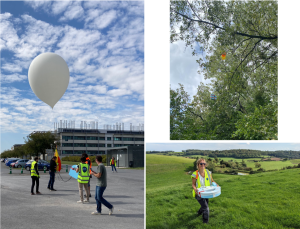
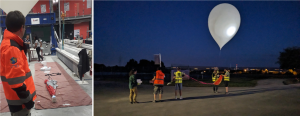

A FULL SCALE day indeed!
Wednesday 13 September
Weather kept improving from morning to evening and data from the various instruments flowed freely today.
At 9:56 LT, the first AirCore from GSMA was launched under a cloudy sky. After a 2 hour flight, it landed smoothly in a field and it was an easy recovery for the GSMA-LMD team. The analysis went well and we got our first look at greenhouse gas concentrations in the atmosphere, up to 25 km, above Reims.
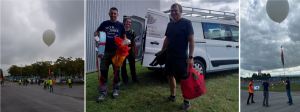
A second AirCore followed at 14:32. Unfortunately, this one landed in a tree and the recovery LMD-GSMA team took a little bit of time. It came back to the lab at 21:04, where the analysis of the gas captured by the instrument started.
Meanwhile, the LSCE team installed their EM27/SUN, protected in its casing, at Base 112, where it will operate automatically for the remaining of the campaign. The first spectra were acquired while some rare sun rays went through the clouds.
The other EM27/SUN teams from LERMA, GSMA, CNES and LMD visited the vicinity of the Bazancourt plant to identify the best locations for deploying the spectrometers. A bucolic excursion, as the clouds began to break.

The change in the weather was well seen from above by SAFIRE Pieper-Aztec, which took off at 15:07 LT for a 3 hour flight. It performed a raster pattern above the Bazancourt plant in order to capture the methane plume coming from the plant.

Finally, in the South West, the first scientific flight of the SCALE instrument was a success. The 2 hour flight of the ATR42 between Aire-sur-l’Adour and Auch, was completed by the launch of 2 LMD AirCores by the CNES team at Aire and the measurement of CNES EM27/SUN somewhere in the Gers. Both AirCores landed right in the middle of the zone scanned by SCALE. And the verdict is in: the flight was a success. It is a go for SCALE to come to Reims in the following days to benefit from the whole suite of instruments deployed in the MAGIC2023 campaign!
The day ended on the launch of 2 more balloons by GSMA at 21:04 and 21:12 LT. Under the stars, the first balloon carried an LMD AirCore coupled to an O3 sonde with the goal of making a nighttime colocation with the Metop-B satellite carrying the IASI instrumenbt. The second balloon was dedicated to the measurement of aerosol with a suite of instruments designed by a joined NASA-LPC2E team.
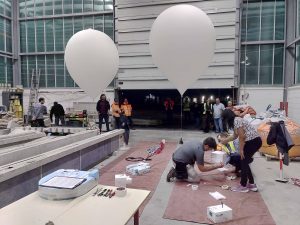
All in all, a very successive first day of measurements!
Tuesday 12 September
The second day of the campaign extented the “MAGIC tradition” of bad weather preventing measurements, with heavy rain hitting the Reims region at 14:00 LT.
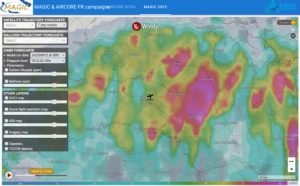
Nevertheless, a few rays of sunshine enabled us to test the casing developed by LSCE for CNES to operate their EM27/SUN automatically. Thanks to the cooperation of the weather regime, the watertightness of the casing was validated…
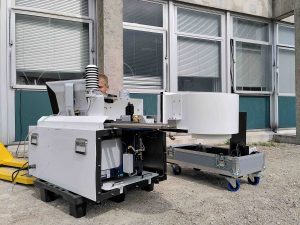
Meanwhile, the calibration of all Picaros was completed BY the GSMA ann LMD teams. Everything is ready for the fisrt balloon launches on Wednesday.
The rest of the day was taken up with planning meetings for future measurement days. Balloon launch times, aircraft trajectories and EM27/SUN deployment options were decided for Wednesday. On the agenda: 3 balloon releases, including two night flights; a raster pattern overflight of the Bazancourt industrial site; and continued mapping of methane digester. The program will be validated at the first briefing on Wednesday morning, at 8:30 LT. Fingers crossed!
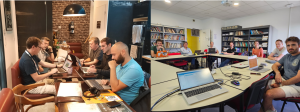
Monday 11 September
First day of the campaign! And many events to report…
After a rough start due to a flooding in GSMA buildings and a power outage, everything went smoothly and all calibration and measurement chains were started. After a full day, everything will be ready for the first balloon flights.
At 12:05 LT, SAFIRE Piper-Aztec landed under a beautiful sky at Prunay airport and was greeted by the whole SAFIRE operational team and some additional MAGIC team members. After parking it in its hangar, the team checked the oboard instruments: Picarro G2401-m, O3 sondes and the newly added NOx TEI. All the lights are green!
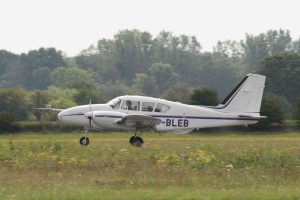
In the meantime, GSMA Picarro was installed on Gerfaut aircraft, which then carried a fligh test around Reims.
Farther South, around Frankazal, SAFIRE ATR42 performed the test flight of the SCALE instrument. After a 1h30 flight, and a quick check of the data, instrument operation is declared optimal. The first scientific flight is planned for Wednesday.
Meanwhile, on the MDF site of Reims, 4 of the 5 EM27/SUN spectrometers have been successfully deployed in order to perform a intercalibration of the instruments and assure they all provide the same quality of data. Unfortunately, clouds come in and the session is stopped short. A new session will take place as soon as the sun is back… on Wednesday!
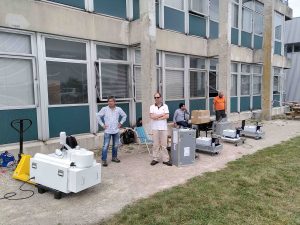
In summary, a very productive day, with most of the teams on site and ready for the new campaign. And above all, an air of family reunion that sums up the MAGIC spirit.
